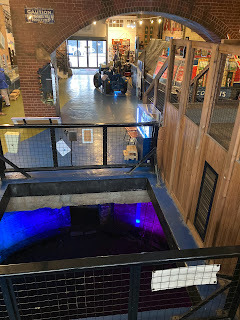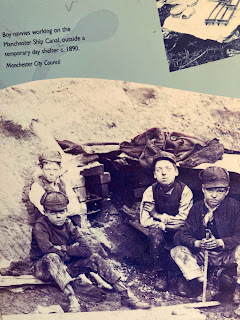Valerie Poore's Blog, page 7
January 12, 2024
A late start to the new year
Well, here we are eleven days into the new year, and this is my first post. Shame on me! First and foremost, let me wish you all a very happy new year. I sincerely hope 2024 brings good things to you all and that we can have less of all the extreme Ws we've been suffering: less weather, less war, less worry.
My last post was well before Christmas and I fully intended to write an end of 2023 roundup as I did last year. I won't do that today, but I might still review the last year as it was a bit of an odd one in many ways. I'm also intending to revive my memoir review blog by writing a summary of all the great travel memoirs I read last year, so if you're a reader, you might like to give that a look through. I'll let you know when I've done it.
As for what we've been doing in the last month, I'll try and condense it into this post with the help of some photos.
The lead up to Christmas honestly wasn't terribly exciting for us personally, unless you count the storms, wind and rain that had us huddling indoors or watching the straining ropes on our boats anxiously. The high waters of 21st December resulting from the ferocious winds of storm Pia prompted the first ever automatic closing of the Maaslantkering, the massive flood gates that protect Rotterdam's port and the largest movable object in the world. In fact, as this article describes, all six of the Netherlands' storm surge barriers (the Delta works being its umbrella name) were closed on that day to prevent an inundation of the kind that flooded the country in 1953. However, as soon as it was safe to do so, they were opened again to release river flood waters rushing downstream from the east.
The Netherlands, like many other countries in Europe, has experienced excessive rains and storms this last autumn, but to the credit of the amazing engineers who manage the water levels in the country, little serious flooding has occurred. That said, water is still standing in the fields, the ditches (sloten) are full and the country's pumping stations must be operating at the max to reduce the saturation.
Sadly for the numerous skaters, our recent cold snap wasn't long enough to freeze these instant lakes into natural ice rinks, but you can guarantee that if the colder conditions return, the skaters will be out in force. I could almost hope they do as I'd rather have the blue skies and sunshine that accompany them than the miserable, grey, wet gloom we've had far too much of.
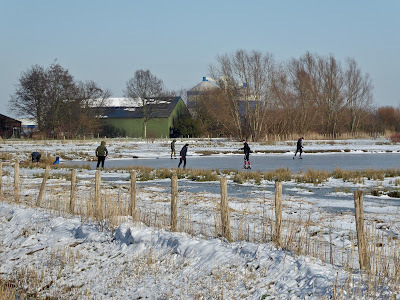 The last time I saw skating on the ponds was February 11 2021
The last time I saw skating on the ponds was February 11 2021Anyway, enough of the weather. Where did we spend the festive season? Well, in France, of course. Being the first Christmas at my daughter's house, we all congregated there on the 26th December. It was the first day travel was really possible as the Christmas weekend was characterised by said howling winds and rain.
We had a great drive down to the Haute Marne although it was very busy on the roads, which surprised us. The rest of the week was blissfully peaceful but also quite full. For most of the time, it was pretty cold but dry, so we all helped with various jobs in the house, ranging from clearing the never-ending junk, to fixing the flushing mechanism on the loo or trying to get doors to open and close without scraping and squeaking. Working kept us warm even if the heaters didn't.
What was a little tricky was that within a couple days the wind picked up and we had to take the Starlink dish down, meaning no internet. The phone signal in the house was also non-existent owing to its nearly metre-thick walls. When Mo was expecting a delivery of some size, I went off to the local bus shelter to make contact with the delivery company to confirm we'd be there. It was the only place out of the bitter wind where I could get a signal on my phone to use as a hotspot on my tablet. Such are the joys of life in the outback of France! I'm not complaining, though. New Year's Eve was bliss. Not a firework in sight, which was wonderful for the collection of cats and dogs we had with us.
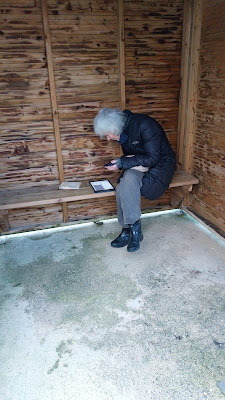 In the bus shelter
In the bus shelterout of the wind and cold
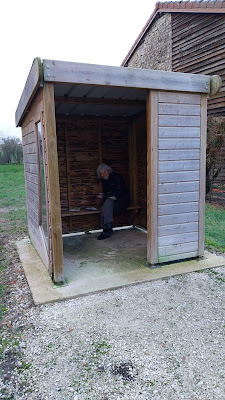
Koos and I also took a couple of afternoon drives into the surrounding countryside to see how the land lay. What a scenic area it is with its deep river valleys, tree-clad hills and picturesque limestone villages. The views from the hilltops were stunning; the hair-pin bends on the steep descents were breathtaking; the swollen rivers and luscious meadows bathed in the afternoon sun were gorgeous. We both agreed it was an area we could live in, and for me, the many long, low drystone walls reminded me of my English West Country youth. Here are some snaps I took. They don't really do it justice, but perhaps they give an impression of the space and beauty.
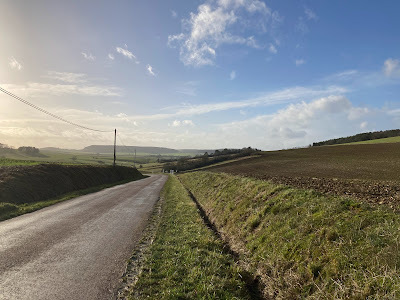
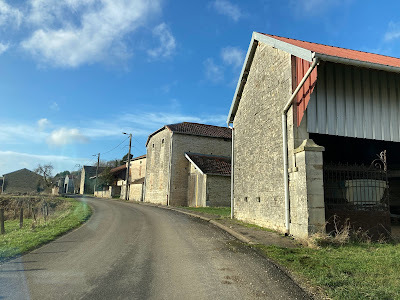
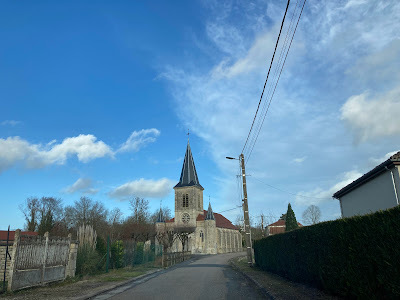
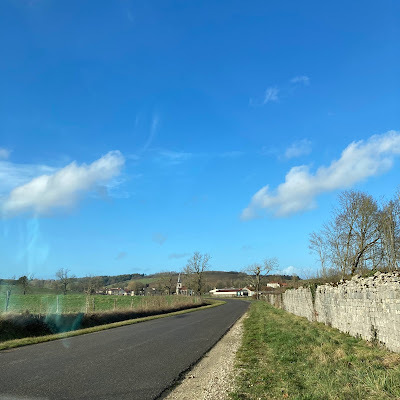
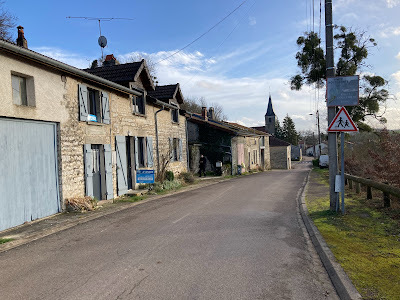
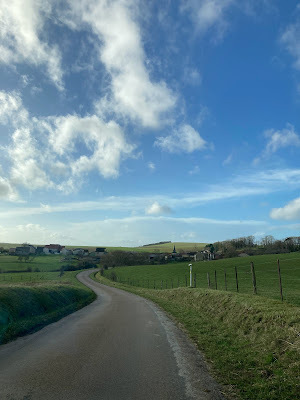
We eventually returned home a week ago, a drive that echoed that wonderful film Bienvenue Chez les Ch'tis, when the main character crosses the border of Le Nord and is deluged by the sudden downpour. The exact same thing happened to us and we arrived back in the Netherlands in pouring rain. Most of the drive north had been in glorious sunshine.
Since then, life has resumed its normal patterns and I'm gearing up to work again. I'm also looking for a new car. To my sorrow, my little Daihatsu Cuore, Buttons, failed her roadworthy test quite severely and I had to make the hard decision to take her to the scrapyard. She'd served me so very well for the last ten years, it felt like a betrayal to let her go in such a way, but without a roadworthy pass, I could no longer drive her and the repairs weren't justifiable. At 25 years old, it was time to hang up her keys and send her into retirement. There's still a part of me that hopes someone will rescue her; she was such a little trooper and I miss her sorely. I've never had such a great little car.
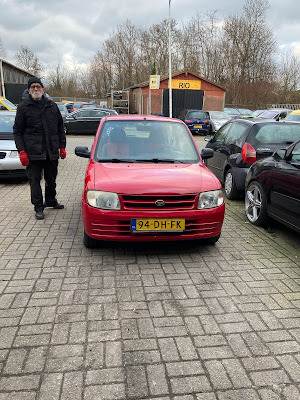 Bye Bye Buttons :(
Bye Bye Buttons :(So that's it allemaal. I hope you've all had a wonderful festive season and that 2024 has started well for you. I know the world is not in a great place right now, but I'm going to focus on the power of the ripple effect in the coming year. Goodwill and kindness are easy to grow, so I hope I can sow some of those seeds too. Happy New Year to you all.
December 15, 2023
High maintenance hounds
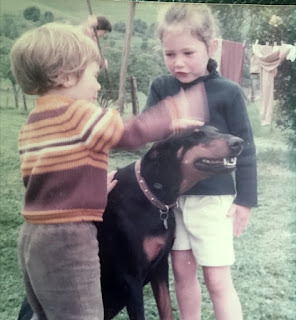 My daughters on the farm in South Africa
My daughters on the farm in South Africawith Cindy 1
Being with and around dogs has been a part of my life as long as I can remember. When I was about three, my mother adopted a golden retriever puppy. Roy, as he was called, lived to the ripe old age of sixteen and was a character with a capital C. He was a terrible thief (he once ate an entire sherry and cream trifle my mother had made), he was not above raiding rubbish bins and eating the contents thereof, and he adored wallowing in the muddiest of puddles.
Despite being a much-loved family member, Roy tended to be a bit short-fused. He bit my brother quite badly once, because Nick tried to pet him while he was asleep; he also bit me one day when I tried to pull him back from the front door when a delivery was being made. When I look back, I realise Roy was very high maintenance, but oddly enough I never paid attention to how much time and effort he consumed, probably because he wasn't my responsibility when I was small.
For instance, I didn't have to wash him off when he appeared black with mud from head to toe after finding a stagnant pond; I didn't have to take him to the vet when he found a chicken carcass in someone's bin and had to have his stomach pumped out to remove the bones that had got stuck –twice (the vet threatened my parents with all sorts of retribution if it happened again); nor did I have to make embarrassed excuses to the guests at their dinner party when he'd scoffed the pudding. My father, or most probably my mother, had to deal with all his sins. For us children, he was our playmate, albeit a somewhat irascible one.
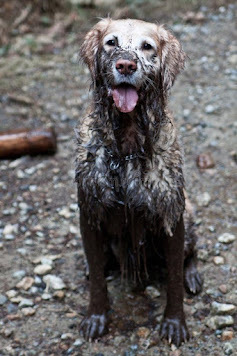 Credit: Arman Werth
Credit: Arman WerthThe photo above is not mine, but it gives an idea of what Roy looked like after he'd been for a good full-immersion wallow. It wouldn't have been so bad if he'd been black, would it? I really have no idea how we managed to get him home and cleaned up after that particular adventure, but I remember he had an amazing ability to 'wear' himself clean. This, of course, meant that he wore the mud off on other things, like the carpets, the furniture, even us.
After Roy, my mother had another golden retriever, Roy 2, but by that time we'd all grown up and moved away, either to university or boarding school, so I don't remember how demanding he was in terms of upkeep and general skulduggery. That said, I do recall my mother saying she could knit us all jerseys from the hair she brushed off him, so he was mostly likely pretty high maintenance as well.
Then, when we went to South Africa, we had other dogs during the years we lived there. They were mostly all short haired (see first photo), so less of a nuisance when they got mucky, which was also not as often because of the generally dryer, sunnier weather. The one exception was Polly the Collie, who was high maintenance not just for her long coat but for a number of reasons, the most awkward of which was her obsession with herding. Nothing, and I mean nothing, that gathered in groups of more than two was safe. This included swans and geese. Foolish dog. Even more foolish was yours truly who plunged into a frozen lake to rescue her when she decided skating on thin ice after a pair of swans was fun. It wasn't. For her or for me.
However, it was when I got my Labrador/Dobermann cross, Sindy, that I really began to experience the meaning of having a high maintenance hound for whom I was 100% responsible.
As those of you who've read Living With My Sin know, Sindy (or Sin as she was aptly known) had issues, one of which was her somewhat bizarre relationship with cars. She totally wrecked the interior of our little Renault 5. I clearly remember the scrapyard dealer looking at the remains of our seats in amused amazement when we realised they, and the car, were completely beyond repair.
"Your dog did that?" he asked, shaking his head. "Well, you'd better take it back."
"Why?" we spluttered.
"Because there are bits she hasn't finished yet," he said, grinning.
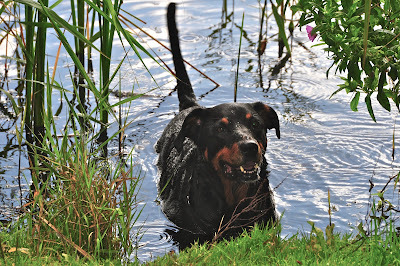 Sindy wallowing happily. Luckily, this time it was clean
Sindy wallowing happily. Luckily, this time it was clean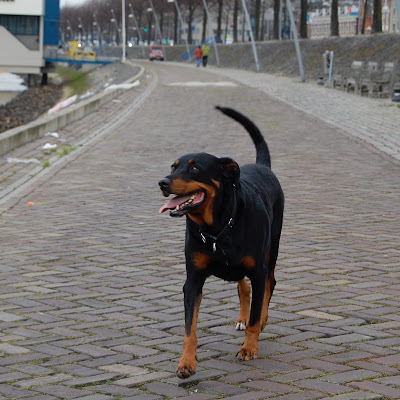 Sindy with a mischievous bounce in her step
Sindy with a mischievous bounce in her stepNaturally, we didn't; even so she also did some severe damage to the crate we made for her in the van we bought to replace the Renault.
But when she wasn't being a one-dog-car-demolition expert or demonstrating her other anxieties in extreme ways, she could also enjoy normal doggy fun – such as charging through muddy puddles, sending filthy spray all over us. Now Sindy was largely black, so it didn't look too bad on her, but I can't say the same for our coats, jeans, faces and hands.
And now we have Zoe. Would you just look at that bundle of cuteness? High maintenance? Surely not! Well, think again. I don't think I've ever spent so much time brushing, snipping, cutting out knots, washing off mud, cleaning ears and generally keeping my little munchkin from looking a total ragamuffin. You see, she's just as fond of dashing through the mud, and being so close to the ground the mud seems equally fond of attaching itself to her. To make matters worse, she hates water, avoids any enticement to go swimming and resists being bathed with vigour. So once again, I end up wetter, dirtier and in even more of a mess than her when I manage to persuade her into the shower.
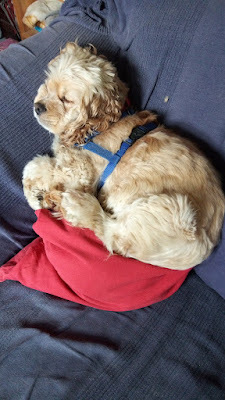 A bundle of cuteness
A bundle of cutenessAnd cute though she looks, she has some revolting predilictions. Every time she dips her nose into something awful (which is often), so do her ears...just saying it is enough, isn't it? Her eating habits would rival those of a Labrador, which is quite a statement, I know, but I'm often reminded of the website where I read that 'spaniels are always hungry'. What they didn't say was that spaniels will eat absolutely anything to assuage that hunger; there are no limits.
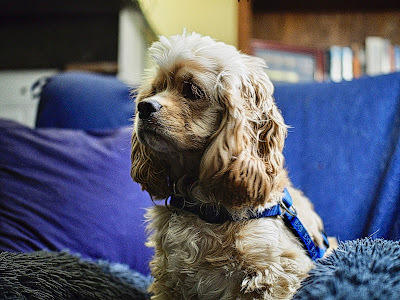
Of course, I always forgive her. How can I not. One pleading look from those limpid dark eyes and I'm lost.
So that's it. The story of my family life with high-maintenance hounds. The years between Sindy and Zoe were the longest I've ever lived without a dog. Reading this, you might wonder why I missed having one in my life so much, but the joy they give is so much more than the trouble they might cause. Seeing Zoe scampering along the woodland paths ahead of me and feeling her constant companionship as she snuggles on the chair behind me when I'm teaching makes it all worthwhile. High maintenance they might be, but they're also very high reward.
Enjoy your weekend, allemaal. There's one more week before the holiday, so I'll squeeze in a Christmas post before signing off for 2023. Till then, keep warm or cool, wherever you are!
December 5, 2023
The London Canal Museum
Last week, I mentioned the London Canal Museum in my post but didn't write about it then because it is really worthy of its own post. So, without further ado, here it is.
Just to recap, we were doing a day trip to London courtesy of the Eurostar, something neither Koos nor I had ever done before, so it was something of an experiment. Given that we only had six hours between arriving in London and departing again for home, we didn't want to spend too much time travelling from one place to another. As a result, we confined our wanderings to the areas around St Pancras and King's Cross.
Having feasted our eyes on our usual suspects – the Regent's canal and all the boats thereon (see last post) – as well as the gasometers, we weren't quite sure what to do next.
"Look, the London Canal Museum is just a short walk from here." I pointed it out to Koos on Google maps. Its position was shown next to the harbour called Battlebridge Basin (also mentioned in my last post).
"Hmm," came the less than enthusiastic response. Koos, like me, doesn't really like museums, preferring to see history in the wild, so to speak. However, a canal museum appealed to me.
"Well, let's just walk to that harbour, anyway. We haven't been there before."
And so we set off, meandering through the back streets in what looked to be the general direction of the canal. I say 'looked to be' deliberately since I have zero sense of direction and it wasn't the same way we'd walked earlier in the day. What I'd forgotten was that in the morning, we'd crossed over the Regent's canal to the north side and turned west. This time, we were staying on the south side and turning a little east.
However, since I don't know my north from my south, let alone east from west, and imagining we were already on the other side of the Regent's Canal, I was taken by surprise when we walked up a side street and saw the entrance to the museum. Yes. I know. It sounds silly, doesn't it? Well, try living in my brain for a while and see how I feel.
Anyway, after some minor discussion about whether to go or not to go, I clinched the deal by saying to Koos, "Come on. I'll pay. At least it'll be warm in there!"
And what a treat it was.
The first item on display we noted after paying our dues was a beautifully restored towpath tractor. This one was built in 1960, and did the job horses were previously used for– towing barges along the canals.
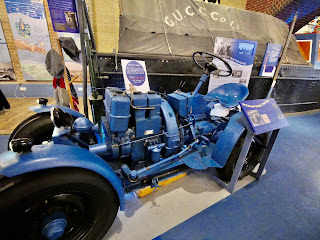
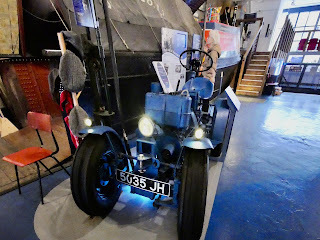
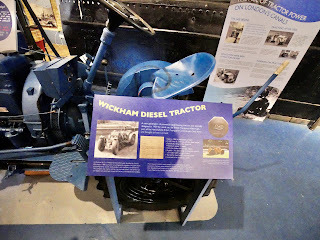
I've always loved old tractors, and this one was a delight to see. The details of its background and purpose are just visible on the information board in the last photo (thank you, Koos). I had to wonder if the horses minded being made redundant by modern technology – as it was then. I could imagine them sighing as they hung up their harnesses for the last time, but I couldn't decide if the sigh would have been of relief or regret.
As I also mentioned last week, this museum was on the site of two ice wells, the inspiration for which came from one Carol Gatti, a Swiss Italian immigrant who came to London to make his fortune in the 1850s and did so. He was a café owner, but he realised money could be made by supplying ice to all sorts of different businesses. His story, and that of the ice wells, is detailed on the Canal Museum's website, which you can find here. In short, though, he started importing ice from Norway not only to supply local business and hotels, but also to provide clean, natural ice for Italian ice cream makers. The imported ice was stored in these wells before being distributed. Previously, ice from local ponds and lakes had been used, but I dread to think how unhygienic that natural ice might have been...it doesn't really bear thinking of, does it?
Another aspect the museum focused on was about the children who both lived and worked on the canals. I was shocked to read that children were even employed to dig canals. In fact, I almost didn't believe it, but the photo below of the child navvies who helped dig the Manchester Ship Canal was somewhat chilling evidence of the truth.
But then children had to help the boatmen as well. The pictures below show a very young boy leading a a donkey along the towpath and a tiny girl tied to the roof of the narrowboat to prevent her from falling off.
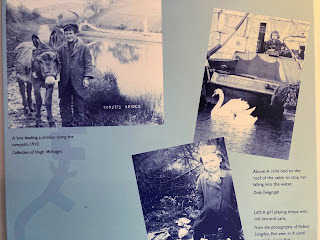
Another photo was of a small girl tying two boats together in readiness for loading. I believe Queen Victoria's husband, Prince Albert, made laudable efforts to reduce child labour, but the legislation he inspired clearly didn't reach the canals. These photos are undoubtedly from the 20th century.
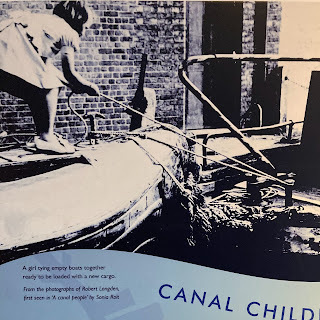
There were numerous other fascinating photos and information boards on canal life in the museum, but I found the two below especially interesting. The decline of the commercial canal traffic naturally began with the advent of train travel, and was further exacerbated when road transport grew. What I didn't know was that the winter of 1962/3 was the final death knell for canal boat transport. With the waterways frozen for months, barges were completely ice bound, leaving it to the trucks and trains to wrest the final slice of the commercial cake from the narrowboating community.
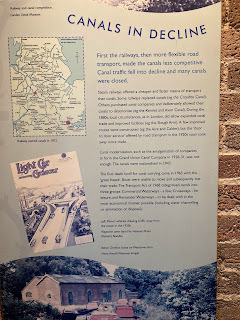
Nevertheless, revival was already happening in quite a different area – that of the pleasure craft industry. It's a heartwarming story of volunteering enthusiasm, but without the teams of eager canal lovers, the English network would not be half as extensive as it is today. The photo below tells the story of how the IWA (Inland Waterways Association) was founded in 1946 and how, with the help of thousands of volunteers, many of the cuts have been reopened, used now by happy cruisers across the country.
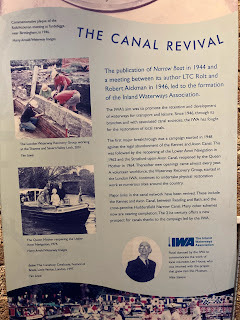
We must have spent well over an hour reading these posters, after which we stepped through the back door into the serene haven of Battlebridge Basin. It was hard to imagine such a peaceful place could exist in the heart of London's inner suburbs, but a resident we spoke to told us it really was as blissful as it looked.
"I used to gaze at this place from the café in that building on the other side," she told us, gesturing across the harbour. "I used to stop for a coffee on my way home from child care with my daughter, and I was determined that one day I'd live here."
Well, now she does. She said she'd had to wait a year to find the right boat to buy in the harbour, but when it came up, there was no stopping her. Was she happy with her decision? The smile on her cheerful face said it all. I've borrowed the photo below from a website titled Battlebridge Moorings, which gives some background to the basin. It's lovely to think these boats will still have the right to moor here for generations to come. Have a read and see its history for yourself.
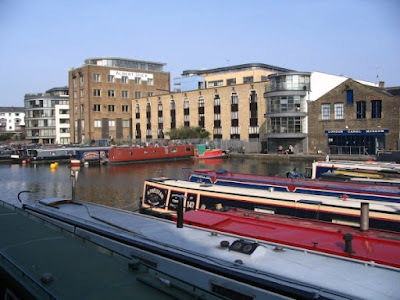 Photo thanks to battlebridgemoorings.co.uk. The museum is
Photo thanks to battlebridgemoorings.co.uk. The museum ison the right-hand side of the photo.
Well, that's it again allemaal. I hope you enjoyed browsing through the museum with me and learnt as much as I did. Next week, I'll catch up with more local doings. Enjoy the rest of this one, wherever you are.
November 25, 2023
London past and present
When my father moved into sheltered housing in the 1980s, the view from his flat looked over the rooftops to a gasometer, and I have a watercolour sketch he painted of which I am very fond.
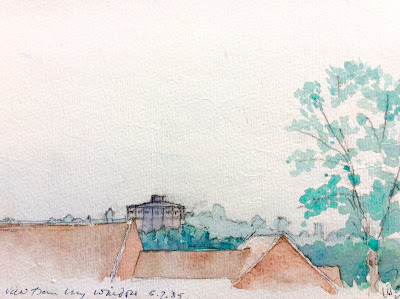 My father's watercolour of the gasometer in Redbridge
My father's watercolour of the gasometer in RedbridgeImagine my delight, then, when we arrived at St Pancras for a day trip to London this last Wednesday and the first thing we saw after heading for the Regent's Canal was the newly renovated area behind King's Cross with its transformed gasometers. The story of how the area came to remain home to these landmarks from my youth can be found here. However, I didn't know that when we arrived.
As is always the case when Koos and I go somewhere, we head straight for the waterside, and coming into London on the Eurostar made this easy for us. The Regent's Canal is just a short walk from the station and it was in the area around St Pancras and King's Cross that we spent the day, absorbing the canal, the locks, the new developments and the old Battlebridge Basin with the London Canal Museum.
Our first sight of the canal was limited to a short stretch of towpath where a number of residential boats were lying. I always enjoy seeing these somewhat motley collections of liveaboard craft, so here are a few
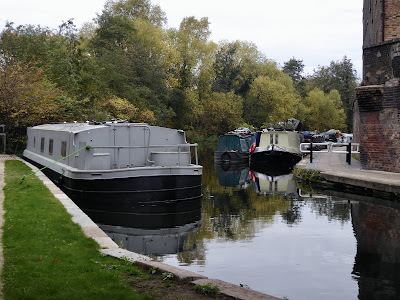 Looking west from St Pancras
Looking west from St Pancras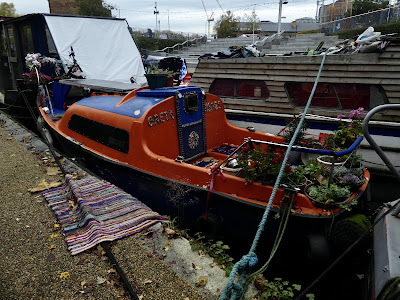 A liveaboard? Hard to imagine, but who knows?
A liveaboard? Hard to imagine, but who knows?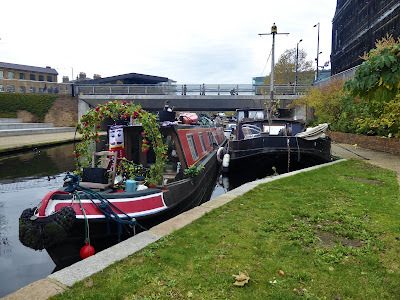 These two were definitely home to their owners
These two were definitely home to their owners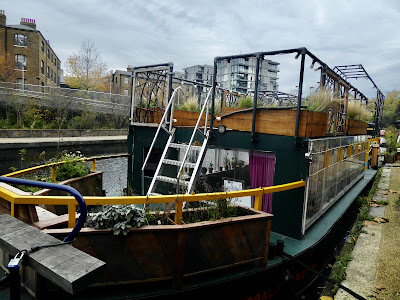
The floating garden
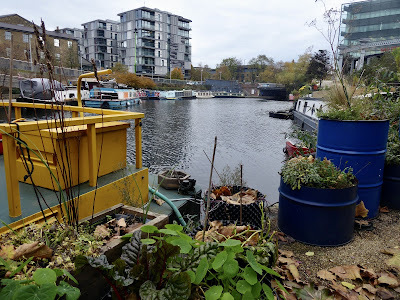 And more boats
And more boats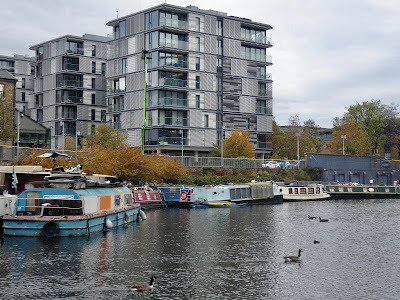
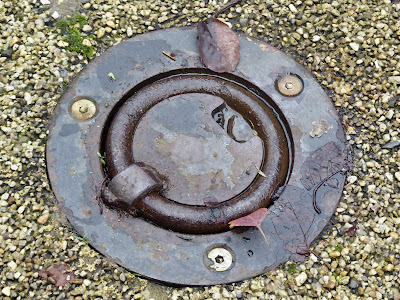 I loved this old mooring ring
I loved this old mooring ringRealising we couldn't go further along this particular stretch, we headed back off the towpath and almost immediately found our way into a shopping complex created from the re-purposed Coal DropsYard. This was the name for the warehouses where coal was received from South Yorkshire for both the nearby gasometers and for transhipment onto the narrowboats on the Regent's Canal. The yard had fallen out of use over the years with the increased use of electricity, as had the gasometers, so it was wonderful to see how these old 19th century buildings and structures have now been renovated to serve another, more modern, function. The gasometer frames are being used to contain apartment buildings as well as a very special small park.
What I loved was that you can see them from every angle, just as we could when I was a child.
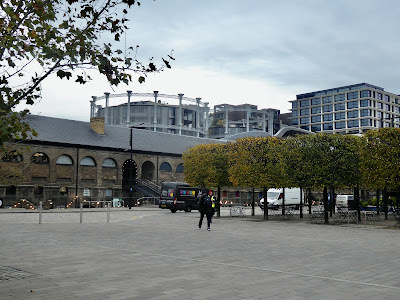 Here they are behind the Coal Drops Yard where we had lunch
Here they are behind the Coal Drops Yard where we had lunch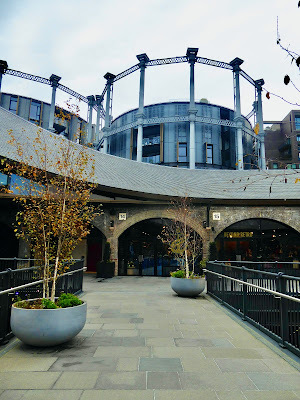 And again as we entered the shopping centre
And again as we entered the shopping centre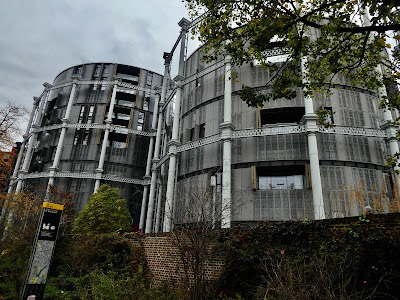 A view from the towpath that we reached from Coal Drops yard
A view from the towpath that we reached from Coal Drops yard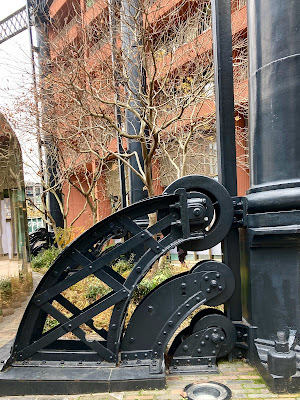 The original mechanism for raising and lowering
The original mechanism for raising and loweringthe holders
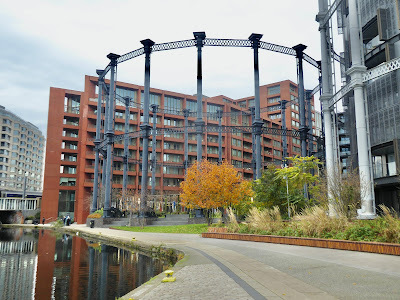 And lastly, the park in a gasometer frame,
And lastly, the park in a gasometer frame, which is there for everyone to enjoy
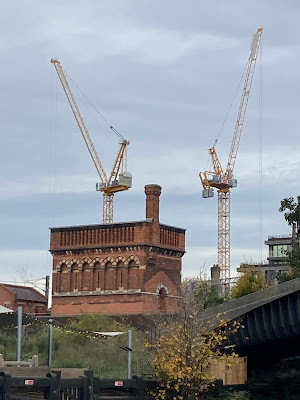 The gorgeous old St Pancras Waterpoint
The gorgeous old St Pancras Waterpoint The lovely St Pancras Waterpoint above is also visible from many different angles. It has a special history as it was designed by the famous architect, Sir George Gilbert Scott and was built in 1872 as the water tower that served the King's Cross steam engines. However, its existence was threatened when the Eurostar tunnel to St Pancras was planned, but being such a historically important building, a decision was made to move it. The story of its relocation is here. I have to say I so admire British historical societies for their determination to maintain their heritage even at what, in this case, must have been considerable cost.
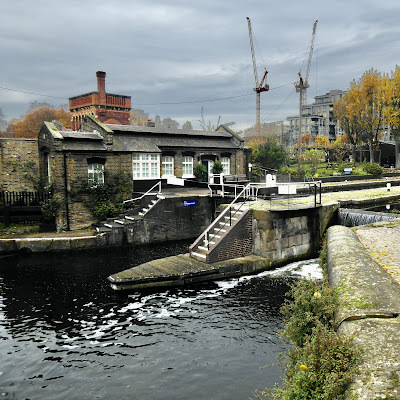 And, of course, we cannot have a canal without a lockThis is St Pancras Lock
And, of course, we cannot have a canal without a lockThis is St Pancras LockAfter lunch, we took a look at King's Cross Station, which is one of my favourites. We didn't get to see the Harry Potter Platform, unfortunately, although I believe the fact it was at King's Cross was a mistake on JK Rowling's part. Apparently, she was thinking of Euston Station a bit further along the road. What's in a name, eh?
Our final stop of the day was at the London Canal Museum on Battlebridge Basin. I think it deserves a post all of its own, so I'll finish here with a photo of the residential moorings in the Basin. If I ever had the chance to live in London again, this is where I'd want to be. What a lovely, tranquil spot it was and right in the heart of the city too. Heaven on a boat!
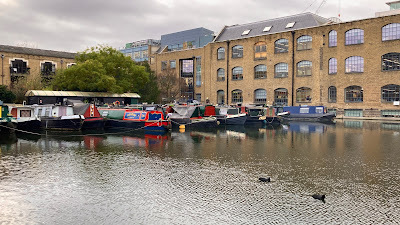
So that's it for this time, allemaal. We only had six hours in London, but we had a wonderful day. Next time, I'll tell you all about the Italians who brought ice to the city. Now that's another story...
November 10, 2023
Haute-Marne, the height of French rural loveliness
Well, here is the post I promised you all about our new destination in France. To recap, my daughter, Mo, has bought a house in the commune of Colombey-Les-Deux-Églises in the Haute-Marne department of France's Grand-Est region. According to that wonderful source of all superficial knowledge, Wikipedia, Haute-Marne is one of the 83 departments created during the French Revolution in 1790. It was made up of parts of the Champagne, Burgundy, Lorraine and Franche Comté provinces, but is dominated by the beautiful Marne valley which runs through the department from its source just south of Langres to Saint-Dizier in the north before continuing out of Haute-Marne west on its way to Paris. The map below shows its course of the river along with all the tributaries that feed it.
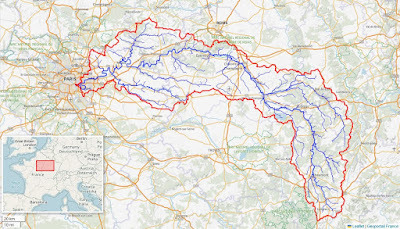 The Marne and its feeder rivers
The Marne and its feeder riversAll the department's major towns are on the Marne. I say 'all', but there are only five of them: Langres, Nogent, Chautmont (the prefecture), Joinville and Saint-Dizier. Of these, only Saint-Dizier and Chautmont have populations over twenty thousand. The other three boast numbers well below ten thousand, with Joinville being the smallest at just over three thousand.
Koos and I visited Chaumont and Joinville and were impressed by the sense of important urban life that both places exuded. Just as an example, our local town on the Dutch/Belgian border, Sas van Gent, has a larger population than Joinville but still feels like little more than a village. Joinville, on the other hand, seems to have bigger muscles and has more self-assurance as a town of substance.
It also has a more aristocratic history than our Sas van Gent. Joinville was originally the site of an important castle in medieval times and gave its name to the title, Prince of Joinville, adopted by the renowned House of Guise. Its heritage is visible, giving a nod to classical French urban architecture in the centre and the delightful shuttered houses lining the Marne’s banks. There is a formal park, the remains of the castle and some gorgeous ancient backstreets, all the more delightful for their air of shabby chic.
None of the photos below are mine, I regret. They are all from tourist sites on the internet and Wikipedia as I posted my own images last time. However, I think these photos show even more what a charming place it is.
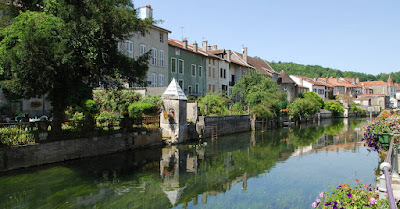
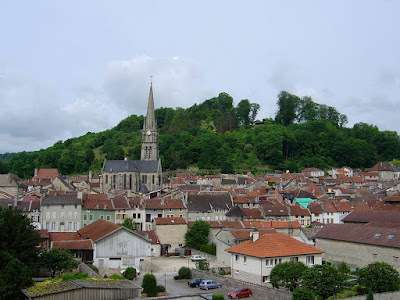
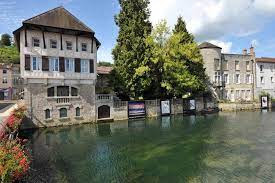
Chautmont, a much larger city as well as being the department capital, also has a long and noble history. Dating back to the 12th century as a seat of the Counts of Bassigny and later of Champagne, there is not much remaining of its early origins, but the basilica dates from the 13th century and there's also the Tour Hautefeuille, an 11th century castle keep, the only morsel left from the chateau of the Counts of Champagne. I was sorry we didn't see as much of Chaumont as we'd have liked, but we've promised ourselves we'll redress that situation next time we go. That said, we had a good look at the amazing 19th century viaduct (as mentioned in my previous post) and had a drive around the town before Karen, our Google Satnav lady had a digital meltdown and got us lost (also in last post). The photo below was the view from the city at the top of the hill where we stopped to give Karen time to reflect on her shameful loss of control.
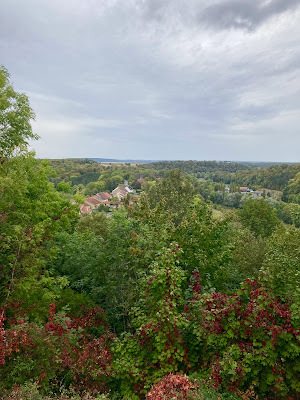 View across the Marne valley from Chaumont's
View across the Marne valley from Chaumont'scity heights
I liked Chautmont's back streets too. The local stone in Haute-Marne is limestone and I loved its pale colour with the gorgeous traditional shutters.
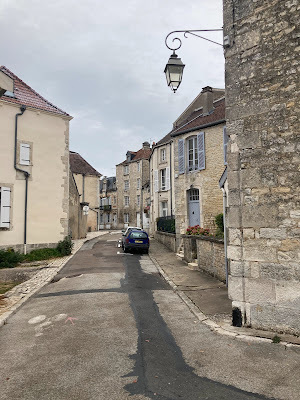 One of the back streets in Chaumont
One of the back streets in ChaumontCloser to Mo’s village, the commune centre of Colombey-Les-Deux-Églises is a picture-perfect, very well maintained village famous for being the home of Charles de Gaulle. His family home was there, it’s where he is buried, and the Cross of Lorraine just outside the village commemorates his distinguished wartime career. I was expecting a town of some size, but it’s small, cosy and very pretty in a neatly manicured way – probably because it attracts so many tourists to the museum that bears his name, which was inaugurated in 2008 by Nicolas Sarkozy and Angela Merkel.

Photo from Wikipedia: Juergen Kappenberg
For me, coming from the red brick environs and eclectic architecture of the north, Haute-Marne offered a serene uniformity in its villages and towns. The overall impression they gave me as we drove through the region was an uncluttered grace, even though many of the rural houses were run down and some were completely dilapidated.
It took me a while to notice something else too: the sweep of the land is unbroken by farmhouses or barns. I can only assume the farmers have their homes and 'granges' in the villages and go out to their farms by tractor. Almost every house in my daughter's hamlet has a barn next to or at the back of it; many of them seem to be full of hay and machinery. Maybe this is the Haute-Marne way? If any of you reading this know, feel free to fill me in. The lack of buildings on the land adds to the impression of remote tranquillity, which I loved. In fact, I am itching to go back again.
So that's it again allemaal. Hopefully, by next week we'll have some dryer weather and I can report on outdoor activities that don't involve replacing broken roof tiles or placing buckets to catch the drips from our leaky sunroom roof. For those who haven't seen them yet, I'll finish with a photo of the Legend of the Ladder himself, Koos, doing the final touches after replacing five tiles that went west with the wind.
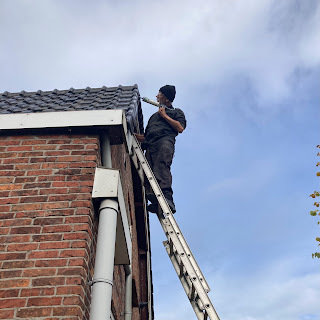
November 2, 2023
Autumn: normal service resumed
Since we came back from France on October the 22nd, life has reverted to the usual autumnal offering of wet, windy weather. We were blessed with some gorgeous sunny days down in the Haute-Marne, but it's true to say that the day before we left even the weather there changed and our drive home ended in ploughing through the back spray from speeding cars on the highway north to the Netherlands.
From that day on, it's been hard to find moments to walk Zoe without getting drenched. My poor little pup doesn't enjoy being wet, so even though I've got her a raincoat, she runs so close to ground, she's pretty much always a soggy, mud-spattered sausage by the time we get home. This sad and sodden state is usually brightened somewhat by the great game of 'fight the towel'–a romp she enjoys with gusto – but it takes ages for her to dry, by which time we have to go out again and repeat the process.
Of course our dug-up road, which is still not finished, isn't helping matters. The company doing the work is supposed to have completed laying the new surface by the 10th of November, but owing to the daily downpours, they can't do much other than turn up every morning, inspect the sandy base, decide it's too wet and go away again. Sometimes, like today, they scrape the sand smooth and do a few more metres, but then the rain starts again and off they go.
Maybe I should explain why the process takes so long. Here in the Netherlands, almost everything is built on sand and that includes the roads. Being a country that was largely wrested from the sea, our soil lacks the kind of substance that 'real land' has. While the tarred main highways and through routes are constructed on solid bases of hardcore that has to be added to the sandy loam, our village street is made up of bricks laid straight onto sand. There is a layer of rubble-type material to give some firmness to the base, but above that is thick, smooth sand onto which the bricks are laid in a sort of hounds-tooth pattern. It looks great when it's finished, but it takes forever to lay when the weather is inclement. The men tell us they cannot work on wet sand because it has no 'give', which seems to be important. I admire their skill, however. It's fascinating to watch them work so neatly and speedily when they have the chance.
 The current status, but they still have about 300 metres to go
The current status, but they still have about 300 metres to go
They first dug the road up at the end of August, two long months ago, but I honestly don't see them finishing it before the end of November. And so we trudge through our own personal beach every day, bringing mounds of it into the house every time we come in. Such is life.
Boat work has also reached a hiatus. There's nothing that can be done when it rains at least part of every day. My dearest wish would be to have something like a large boathouse where we could just work on under cover; wouldn't that be great? If anyone knows of one for hire in this area, do let me know.
By the way, I know I promised you all some more on the area around my daughter's new French home, but work has been very busy this last week, so I haven't had time to do any further research. Next time, I promise. For now, we're just waiting for storm Ciarán to move on. Like a hyper-active child on the rampage, he's made something of a mess on our country roads, but so far, no other damage. My thoughts are with all those on the French and British coasts who've taken the worst hammering.
That's it for this time then, allemaal, so here's a gratuitous photo of Zoe, courtesy of Koos, and a boaty pic or two to remind you of where my interests really lie.
Update on the storm: we've lost most of the edging tiles off one end of our roof, one of which also smashed the windscreen on Koos's scooter as it went flying. Fingers crossed Ciarán has finished with us now as we'll need to get up there and replace them asap.

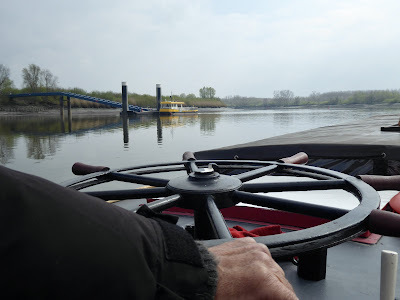 On the tidal Schelde/Scheldt in April
On the tidal Schelde/Scheldt in AprilWhat a wonderful trip that was
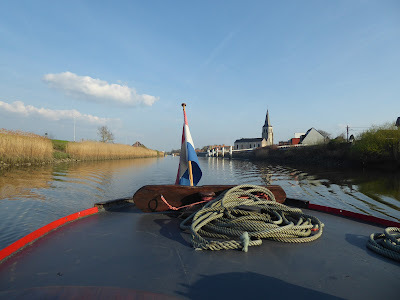
October 23, 2023
Further forays into France
In September, you might remember we made a trip into the southern Champagne region of France to see the house my daughter has bought in the Haute-Marne department. We were struck then by the loveliness of the area, but now we've just spent a full week there, it has struck us even more.
Koos and I drove down on October the 15th, a month to the day after our previous visit. This time, we went in our own car, our venerable 28-year-old Opel Astra, which cruised sweetly through the rolling French countryside as if it enjoyed stretching its wheels. There's no denying it's quite a long drive at approximately 500km, but it's not a hard one. The most taxing part is around Lille, which encompasses a huge urban sprawl, but we were able to escape most of that by ducking a bit east and following the road around Tournai. After that, there's a relatively short stretch of the A1 to Paris before we turned off onto the A26 south to Reims. I must say I was highly entertained by our Google maps lady (whom I named Karen), telling us to take the exit onto the A26 and just stay on it for 157km. As soon as she said that, she shut up and went to sleep until we reached the ring road around Reims.
I've never been much of a fan of these Satnav apps before, but I was very grateful to Karen on this trip. She was very useful everywhere except in the city of Chaumont, the capital of Haute-Marne, where she definitely got several wires crossed and had us going down a tiny track we could barely find a way to extract ourselves from. After that, she got in a total tizz and we had to switch her off to recover herself. But apart from this brief fit, she was a tower of strength and led us not only to my daughter's village, but also to Joinville, the Marne river and various other locations in this stunning part of France.
For most of the week, we stayed local, as we were there to help Mo clean up the house and start cleaning the junk of ages from the barn and workrooms attached to the house. There's a lot of clearing up to do, some roof repairs needed and some serious decorating to be done, but the house itself is perfectly fine. While a bit cold and lacking in creature comforts, we were all grateful for the furniture that had been left behind. But even that mattered little when given the lovely environs, kind people and tranquillity of the farmlands around the village.
The French have not had the best reputation when it comes to welcoming strangers in their midst, but Haute-Marne has to be the greatest exception to this (underserved, in my opinion) rule. The villagers are warm, welcoming and very friendly. We've had lovely exchanges with many of them, but the absolute highlight for me was our visit to the local council offices (the Mairie) at Colombey-les-Deux-Églises. Mo is at the early stages of learning French, but they were so kind and so encouraging when she explained what she was there for. The mayor himself joined in, asking her which house she'd bought, and when she told him, he was full of congratulations. It really was a joy to experience.
As for our brief excursions, Joinville is a beautiful town on the Marne and still more attractive to us because of its parallel canal. It reminded me of a mini Seville, with its narrow streets and ancient, shuttered houses. Chaumont, on the other hand, is an impressive city with a jaw-dropping railway aqueduct. Set on a steep hill with its basilica at the top, it overlooks the Marne valley with stupendous views. Unfortunately, the afternoon we went there, it was rainy and overcast, but I can imagine the scenery and the city are stunning on a sunny day.
Here are a few of the photos I took:
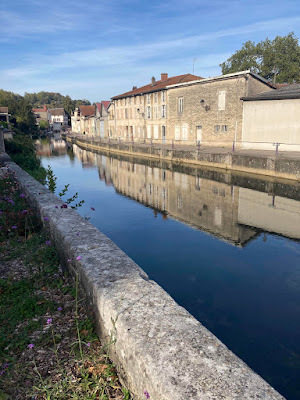 The canal through Joinville
The canal through Joinville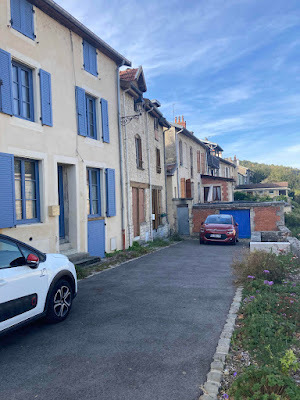 Lovely traditional blue shutters on the houses
Lovely traditional blue shutters on the houses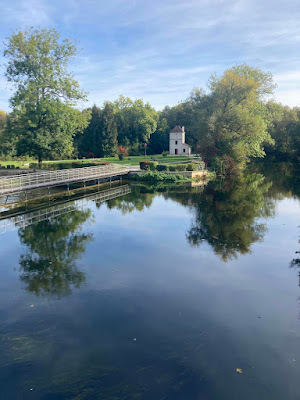 A park next to the canal in Joinville
A park next to the canal in Joinville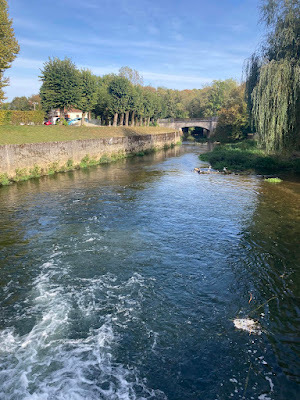 Joinville
Joinville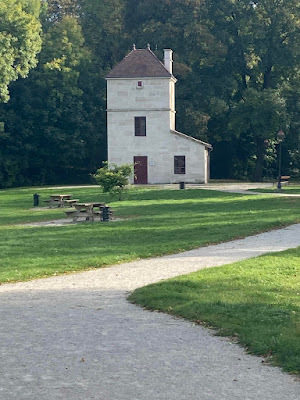 Restful tranquillity in the Joinville park
Restful tranquillity in the Joinville park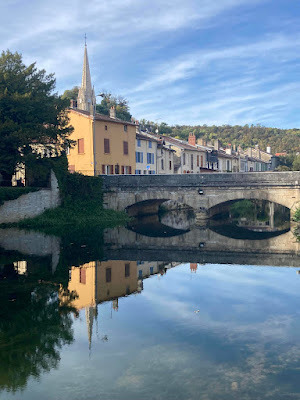 Joinville
Joinville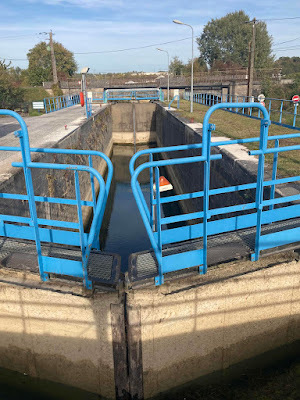 The canal between Champagne and Burgundy at
The canal between Champagne and Burgundy atGudmont
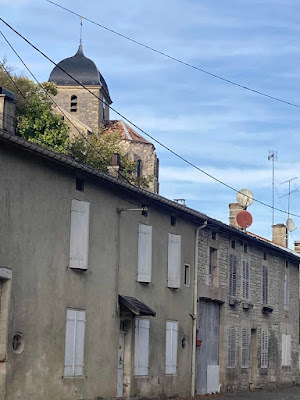 Gudmont in the commune of Villiers
Gudmont in the commune of Villiers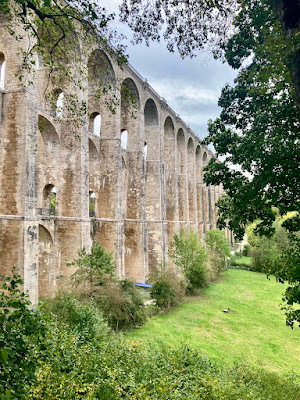 The aqueduct at Chaumont
The aqueduct at Chaumont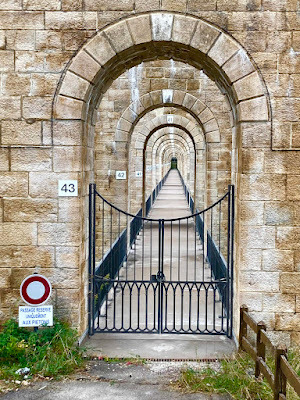 Looking through the aqueduct at Chaumont
Looking through the aqueduct at Chaumont
Altogether, it was quite an intense but very enjoyable week in the heart of France's Grand Est region. We'll definitely be spending more time there in future. There is so much history and so much beauty in the area. I haven't even mentioned any of it here, but there will be more to come, that's for sure.
Have a good week allemaal, and I'll fill you in on some of the history we encountered next time.
October 6, 2023
Where has the time gone?
It only seems like yesterday I was writing a summing up of August, albeit in September, but here we are at the end of the first week of October and I feel I've completely lost September in a kind of hazy mist. Okay, we had the grand adventure into France on the weekend of the 15th, halfway through the month, but for the life of me, I can't remember much of what we've done since then.
I know there's been quite a bit of boat painting involved – not major, large areas, but details like the railings on the Hennie H, which both Koos and I have been busy with (fiddly and time-consuming).
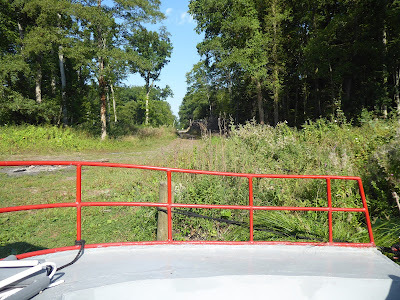 Fiddly, time-consuming railings
Fiddly, time-consuming railingsAnd I've repainted more of the panels on Vereeniging, which I need to do every year. I wish I could find solid wood in the right sizes at an affordable price. The thick plywood I've used lives up to its name as the ply part tends not to survive much in the way of wet weather, no matter how much I smear kit along the edges and paint them. I've replaced them all over the last few years, but the first ones I did are already showing signs of weather damage.
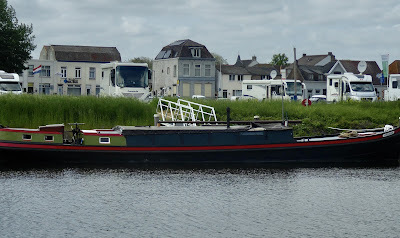 I've replaced all the side panels over the years
I've replaced all the side panels over the yearsBut the biggest job was last weekend's efforts to replace three engine cover gaskets on the Vereeniging. Again, on paper this isn't a big job, but it took time and the two of us spent most of last Saturday and Sunday doing it. The first job was to drain the sump of oil, which involved running the engine until it was warm – something Koos particularly enjoys, although I love the sound of the Samofa (aka Leaky Lou) as well. Then he sucked the old oil out with the nifty hand pump built onto the engine block. Having done that, the three covers were removed, which is where I came in.
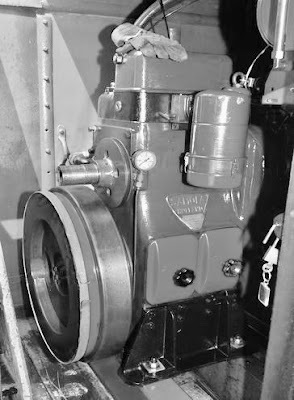 Two of the engine covers with their knobs
Two of the engine covers with their knobswhich unscrew to remove them (not my photo
by the way. It comes from a website called De Binnenvaart)
My job was to peel off what remained of the old gaskets and sealant, clean them and their mountings, (which look like the photo below when they're clean), and apply new sealant on both sides of the gaskets when replacing them.
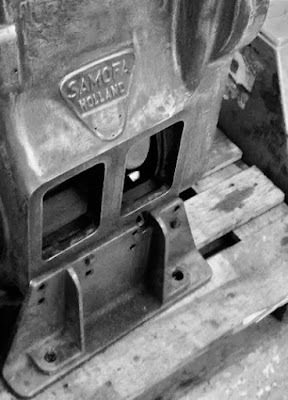 Also not my photo. This one comes from
Also not my photo. This one comes froma website called Marine Power Services
The most difficult part, oddly enough, was putting the covers back on. The knobs you can see in the first photo control a kind of cross bar at the back of the cover, which has to go inside the engine and be twisted round until it holds the cover in place. You then fix them by screwing the knobs back in. Sounds easy, yes? Well, no. Because the cross bars are longer than the height or width of the openings, you have to put them in diagonally. But even that is unbelievably tricky.
Koos tried top right to bottom left; it didn't work. Then he tried top left to bottom right. That didn't work either. Agh! However, in both these efforts, he was trying to put the bottom of the cross bar in first. After numerous frustrating attempts and a bit of damage to one of the new gaskets (sigh), we eventually discovered it was essential to put the top of the cross bar in first, lift the cover up a bit and then the bottom of the bar would go in easily. Voilà! The reason? There's more room to manoeuvre at the top than the bottom; it really was that simple.
After this revelation (and a good half hour), the process went smoothly and all the covers were back in place. You have no idea how relieved we were.
The only thing left was to put new oil in the engine, which I didn't yet have. With these old motors, it's best to use 30 grade oil. Sorry for being technical here, but normal vehicles use 10-40 grade. Just so you know. Thirty grade is a bit more expensive, of course, but luckily I can get it locally, so with seven litres now in the car, tomorrow will be the day for testing whether all our efforts have helped reduce a few of Lou's leaks. Fingers crossed!
See? This is what my memory is reduced to. I can only think of these paltry highlights to the weeks to mark the passing of the month. Maybe I need to add a few photos that I took in our neck of the woods to the mix.
Have a good weekend, allemaal and enjoy your autumn/spring wherever you happen to be.
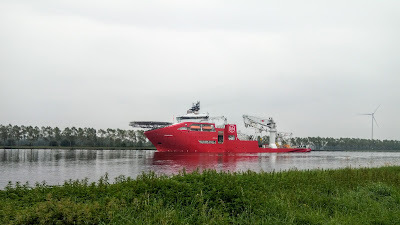 A rather unusual ship. I have no idea what it's for so if anyone
A rather unusual ship. I have no idea what it's for so if anyonehas a clue...?
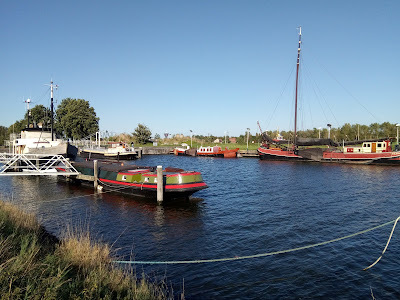 My beautiful barge in our lovely harbour
My beautiful barge in our lovely harbour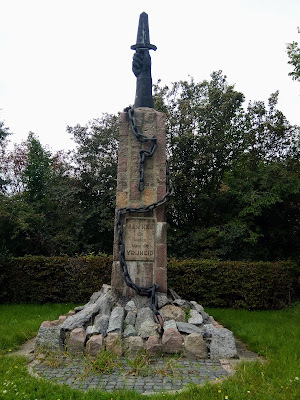 A moving war memorial I discovered in
A moving war memorial I discovered in Terneuzen our nearest town
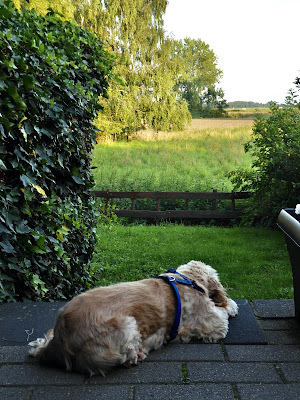 Zoe guarding her terrain
Zoe guarding her terrain
September 25, 2023
A flying visit to France plus other (in)consequential happenings
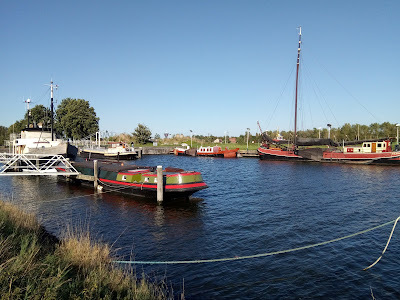 Just a pretty scene as a header for the blog and to show
Just a pretty scene as a header for the blog and to showmy happy place
I've been lax again – well, no, not really. It's more that things have been pretty busy and exciting lately while life in general is a bit more taxing.
Before I get into the visit to France, the taxing part is that our road has been dug up yet again. Some of you may remember that two years ago, we were unable to park next to the Crumbly Cottage or drive past it for several months owing to work on the drains. Well, when they finally finished, they just relaid the brick surface (we don't have tar here) on a temporary basis. Last year, a large section of the road was re-surfaced over the course of several more months resulting in our access being cut off again. But, they didn't reach our section, so this year, they are doing the part in front of the cottage and for a couple of hundred metres on either side of us. Sigh.
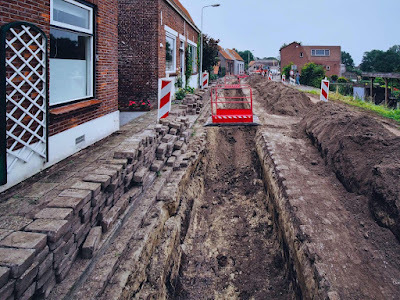 2021, 2022 and now again in 2023, the dyke near us is dug up
2021, 2022 and now again in 2023, the dyke near us is dug upfor months on end
It feels as if we'll never see the end of it, but they predict it will be finished in November. The main problem for us is we cannot access ou house with any kind of vehicle, which has consequences for our wood supply this winter and also for delivering parcels. I won't bore you with an extended moan, but suffice to say it's getting to be a bit of a burden, especially with the wet weather we've had recently. The mud, and if not mud, the sandy dust. Trudging through puddles ... with a spaniel. And then coming into a house with carpet, where every surface is covered with a layer of sand. Need I say more?
Okay, that's the taxing part. The busy part is that I've started work again, there's still painting on the boats to do, and we're trying to keep up with engine maintenance as well. I'm honestly not moaning about any of that as I enjoy my work as well as all the boaty jobs.
The exciting part is the new French connection. My daughter has finalised the purchase of a fixer-upper house at the southern end of the Champagne region. Just a few kilometres from the Marne river and its sidekick the Canal entre Champagne et Bourgogne (The canal between Champagne and Burgundy), it's in the incredibly beautiful Haute-Marne department and close to the town of Colombey les Deux Églises, where Charles De Gaulle had his home. The transfer took place on the 15th of September, so Koos and I went with her for moral support. And of course we were very curious to see the house in the flesh, so to speak.
It was a six-hour plus drive including stops for breaks for the dogs as much as for us. We left at sparrow's whotsit (6.15 a.m.) and arrived sometime after 12.00, although don't remember exactly what time it was. Our first stop was at the house, so we headed for the village and were completely captivated by how beautiful the area was. Rolling hills, wooded copses, fields full of sunflowers (past their prime, sadly) and picturesque stone villages. When we arrived at my daughter's house, we were amazed by its size and the extent of its buildings. It's a fine, well-proportioned home that would be called a villa here and I can well imagine it will look beautiful with window boxes of geraniums and freshly painted shutters, which we found in the garage.
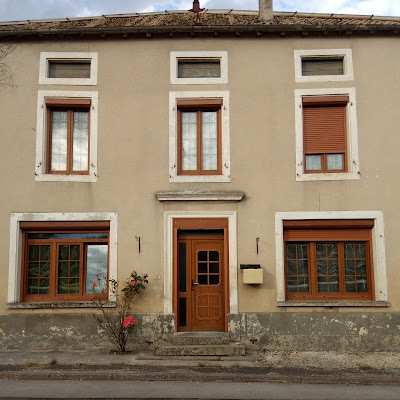 After cleaning the windows and weeding the steps, the house
After cleaning the windows and weeding the steps, the housealready looked a little more loved. It just needs its shutters back!
After a walk around and some entertaining but time-consuming wrangling with the pop-up toilet tent Mo carries for emergencies but which refused to un-pop, it was time to meet the estate agent for an interior check. I'd seen plenty of photos, but it was still impressive to see it for real. Luckily, the former owner had left some basic furnishings, which made the house look more homely and also gave us something to sit on and at in the evening. The tour of inspection over, we drove another twelve kilometres to Doulevant le Chateau to the notary. Koos and I were in charge of the dogs for the two-hour appointment and since by this time it was quite hot, I volunteered to take them (Zoe and Mack) for a walk while Koos had a snooze in the car.
We made our way along a path out of the village and into gorgeous countryside. It reminded me of England's West Country and the area around Maastricht and I realised she'd chosen a delightful place to make her home if she chose to move there full-time in the future.
When I returned, the deed was done and Mo told us we were all invited to the sellers' home for a celebratory drink– all being the three of us, the estate agent and Mo's interpreter. For me, this was the highlight of the trip. We were welcomed into Michel and Jeanne's spacious dining room, champagne was poured and a wonderfully multi-lingual conversation ensued. Michel and Jeanne were such warm, friendly, spontaneous people and the estate agent was so bubbly, we were all laughing and chatting together in no time, despite the limitation of Mo's and my French. The interpreter, Marjon, spoke Dutch when needed, so we had that to fall back on, but it was a wonderful welcome to the area and I'm sure more good friendships will be made in due course.
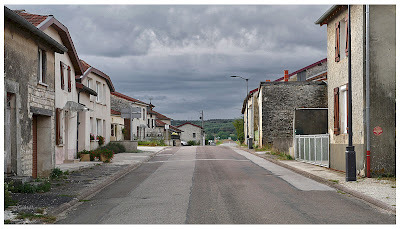 The village street in the morning (courtesy Koos Fernhout)
The village street in the morning (courtesy Koos Fernhout)Back at the house, we set to wiping tops, sweeping up cobwebs and generally making a few areas fit for camping out that evening. Of course, we were pretty tired, so after a salad supper we'd brought with us, and a walk through the starlit evening village, we retired to bed: Koos and I on an airbed upstairs and Mo on a sofa. The upside was the tranquillity and stillness of the night; the downside was the bells from the church almost opposite. I heard them ring on the hour, every hour throughout the night. I suppose you get used to them eventually...?
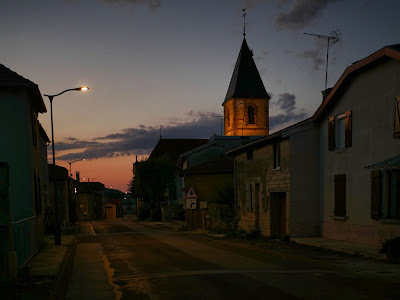 The evening walk, just before the stars lit up the sky
The evening walk, just before the stars lit up the skyOn Saturday morning, Mo and I were up early to walk the dogs and I marvelled again at the peace–apart from the regular rings from the spire above. We were planning to leave around 9 a.m. for the long haul back, which gave us a couple of hours to do something useful. Mo cleaned the front windows and I weeded the steps and the area in front of the house. What a difference even these two jobs made!
"It already looks loved again," wrote Jo, my other daughter, when I sent her a photo.
The return journey took a little longer as we made more stops. We arrived home mid-afternoon, although for poor Mo, it took a lot longer. The car broke down on her way home, so she had to call the Dutch version of the AA. They managed to fix the issue temporarily, but now she has to have the problem investigated and repaired. All the same, it was a great trip and a wonderful adventure into a part of France I didn't know. I have a feeling we'll be going back in the not-too-distant future.
That's all for this time, allemaal. Enjoy the rest of your week, and I'll catch up with the rest of our doings in the next post.
September 11, 2023
Open Monuments Day
I don't know if I've mentioned it on my blog before, but every year in the Netherlands we have an 'open monuments day' when the public get the chance to either go into historic buildings that might otherwise be closed, or get into old cars, machinery and, in our case, boats.
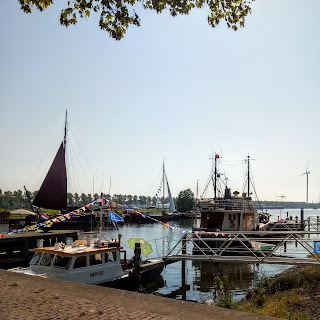 Our harbour in festive mode
Our harbour in festive modeIn our area, the focus is different every year. This time, it was on the historic boats in our harbour at Sas van Gent. As permanent 'liers' (liggers in Dutch), we were asked if we'd be willing to participate and be on board to receive visitors to tell them about Vereeniging and her history. At first we weren't sure if we'd be here, but once we knew we would, I set to and made an information board to explain about the history of the barge. Below is an image of what I used, although the main board was in Dutch. The English text was taped to the electricity box in case there were any non-Dutch/Flemish visitors. :)
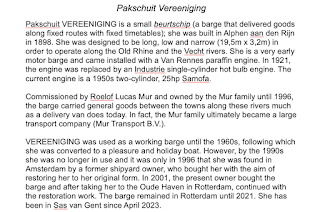
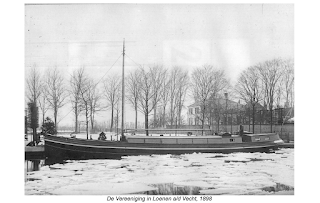
I must admit I hadn't expected much interest, so when I saw the other boats with their bunting, I was a little sorry I hadn't thought of doing more. As it happened, it didn't matter because the organisation by the local society was very good.
It was a scorcher of a day, so they set up a table with an umbrella on the quay and directed visitors to the boats. We had several sets of people coming to see us and it was really lovely to be able to tell them more about Vereeniging's past life. The interest was genuine and the contact was very rewarding. One woman told me she frequently walked around the harbour and had often wondered about the boats, so she was especially pleased to have the chance to see them and ask questions.
Of course, the men amongst the visitors wanted to know more about the engine, so we started it and Koos entertained the eager diesel fans with stories about oily bits past and present. In her 125 years of life, Vereeniging has only had three engines: a horizontally placed paraffin engine (installed in 1898 when she was built), a single-cylinder hot bulb engine (installed in 1921) and her current two-cylinder 1950s Samofa (installed in 2006). Her current engine is still a classic and the reason for much attention for those in the know about pistons, valves and all the other associated parts. Cooling systems are always of interest, as are exhausts. I am not immune myself, as I'm quite fond of our old engine and very well acquainted with its innards.
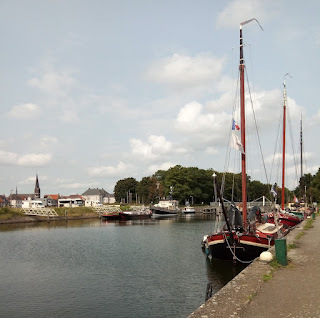 The Historic Harbour, Sas van Gent
The Historic Harbour, Sas van GentAnyway, by lunchtime, we were fairly well roasted and the number of visitors had dwindled. I couldn't blame them; it was over 32C in the shade and we were in the full sun. Given the situation and the fact we'd got a little dog parked under an umbrella, we decided to call it a day and retreat to cooler climes. All in all, though, it had been a great day and well worth the effort.
Have a good week allemaal and hoping the weather gods smile kindly on you all wherever you are.

